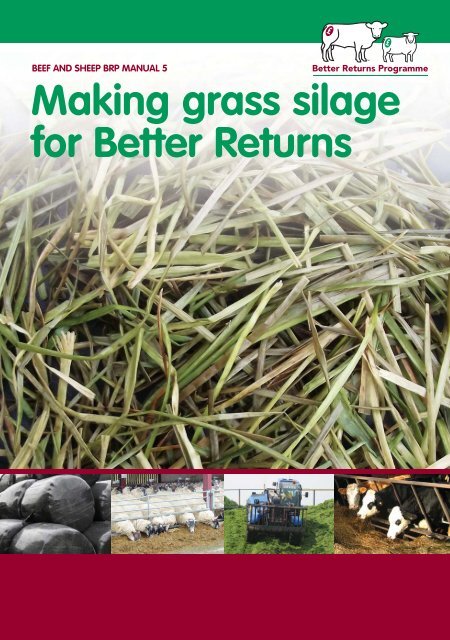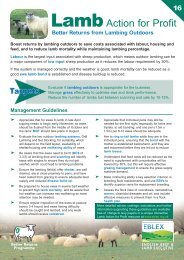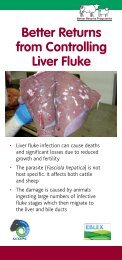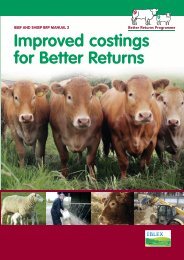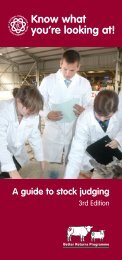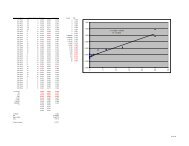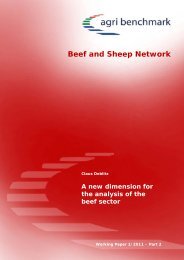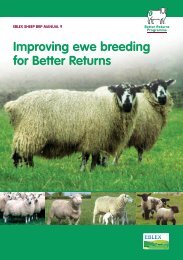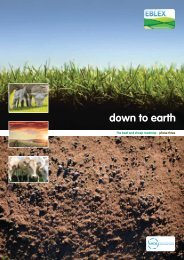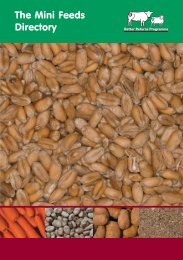Making Grass Silage for Better Returns - Eblex
Making Grass Silage for Better Returns - Eblex
Making Grass Silage for Better Returns - Eblex
Create successful ePaper yourself
Turn your PDF publications into a flip-book with our unique Google optimized e-Paper software.
BEEF AND SHEEP BRP MANUAL 5<br />
<strong>Making</strong> grass silage<br />
<strong>for</strong> <strong>Better</strong> <strong>Returns</strong>
The in<strong>for</strong>mation in this booklet has been sourced from: The <strong>Grass</strong>land<br />
Development Centre and IBERS, University of Aberystwyth; the <strong>Silage</strong><br />
Advisory Centre (www.silageadvice.com); Kingshay Forage Choice,<br />
Costs and Rotations Report 2010; British <strong>Grass</strong>land Society;<br />
www.silagedecisions.co.uk; DairyCo <strong>Grass</strong>+.<br />
Illustrations: Tebbit Design<br />
Photography: ADAS, BGS, EnviroSystems UK Ltd, NADIS<br />
For more in<strong>for</strong>mation contact:<br />
<strong>Better</strong> <strong>Returns</strong> Programme<br />
EBLEX<br />
Ashton House<br />
Ambury Road South<br />
Huntingdon<br />
Cambs<br />
PE29 3EH<br />
Tel: 0870 241 8829<br />
Fax: 0844 774 6253<br />
Email: brp@eblex.org.uk<br />
www.eblex.org.uk<br />
EBLEX is a division of the Agriculture and Horticulture Development Board (AHDB).<br />
© Agriculture and Horticulture Development Board 2011. All rights reserved.<br />
-<br />
EBLEX <strong>Better</strong> <strong>Returns</strong> Programme has<br />
funded the writing and publication of<br />
this booklet. While the authors have<br />
worked on the best in<strong>for</strong>mation available<br />
to them, neither the <strong>Better</strong> <strong>Returns</strong><br />
Programme, nor the authors shall in any<br />
event be liable <strong>for</strong> any loss, damage or<br />
injury howsoever suffered, directly or<br />
indirectly, in relation to the booklet or<br />
the in<strong>for</strong>mation on which it is based.<br />
Reference herein to trade names and<br />
proprietary products and services<br />
without stating that they are<br />
protected does not imply that they<br />
may be regarded as unprotected and<br />
thus free <strong>for</strong> general use.<br />
No endorsement of named products<br />
or services is intended nor any<br />
criticism implied of other alternative<br />
but unnamed products.
Contents<br />
2 Growing good grass<br />
4 Nutrients <strong>for</strong> silage<br />
5 Big bales or clamp?<br />
6 The ensiling process<br />
8 <strong>Making</strong> good silage<br />
10 <strong>Making</strong> good<br />
silage bales<br />
11 <strong>Making</strong> good<br />
clamp silage<br />
12 <strong>Silage</strong> analysis<br />
14 Calculating winter<br />
feed rations<br />
16 <strong>Making</strong> up a <strong>for</strong>age<br />
shortfall<br />
17 Calculating the cost<br />
of silage<br />
1<br />
<strong>Grass</strong> grown <strong>for</strong> silage has different needs to<br />
grass grown solely <strong>for</strong> grazing. Done well, it can<br />
provide high quality <strong>for</strong>age <strong>for</strong> winter feeding.<br />
As with all crops, good silage depends on using<br />
the right varieties of grass, while optimising<br />
soil conditions <strong>for</strong> growth. Then many<br />
management decisions are needed, including<br />
how to store, when to cut and how to feed.<br />
Producing silage is not cheap. So the challenge<br />
is to produce enough of adequate quality <strong>for</strong><br />
the stock that is going to eat it, be it dry cows<br />
or finishing cattle.<br />
This manual covers many of the key issues<br />
when making silage.<br />
Tables at the back can help you work out<br />
how much silage you have, and to calculate<br />
how much it costs to produce – which is<br />
useful <strong>for</strong> comparing it to other potentially<br />
‘cheaper’ alternative feeds that may be<br />
available locally.<br />
Dr Liz Genever<br />
Livestock Scientist<br />
EBLEX
Growing good grass<br />
The starting point <strong>for</strong> growing good grass <strong>for</strong> silage is the soil.<br />
Having adequate fertility and good structure are crucial.<br />
Less than 10% of beef and sheep farmers regularly soil test; and few dig holes<br />
to check what is happening under the surface. Without attention to the soil,<br />
grass and silage yields will be compromised.<br />
BRP has produced a manual which takes a closer look at managing soils <strong>for</strong><br />
best returns from grassland. Email brp@eblex.org.uk or call 0870 241 8829<br />
to request a free copy.<br />
Selecting the right types of grass<br />
<strong>Silage</strong> can be cut from a variety of field types, from specialist short-term leys to permanent pastures<br />
that are mainly grazed.<br />
Ryegrasses have been bred <strong>for</strong> many decades <strong>for</strong> yield, quality and the ability to utilise nutrients.<br />
They are important <strong>for</strong> silage making.<br />
Both white and red clover can also make excellent conserved <strong>for</strong>age, but selecting the right type is essential.<br />
Perennial ryegrass<br />
(diploid)<br />
Perennial ryegrass<br />
(tetraploida) Italian ryegrass<br />
Hybridb ryegrass<br />
White clover<br />
(small leaf)<br />
White clover<br />
(medium leaf)<br />
White clover<br />
(large leaf)<br />
Red clover<br />
Specialist silage Medium term cutting and Long term cutting and<br />
leys (1–3 years) grazing leys (2–4 years) grazing leys (5+ years)<br />
✘<br />
✔<br />
✔<br />
✔<br />
✘<br />
✔<br />
✔<br />
✔<br />
✔ ✔<br />
✔<br />
✘<br />
✔<br />
✘<br />
✘<br />
✘<br />
✔ ✔<br />
✔ ✔<br />
a Tetraploids have a more upright growth habit and work better in a cutting system.<br />
b Hybrid ryegrass is a cross between perennial and Italian varieties, combining the strengths of the two parent species.<br />
2<br />
✔<br />
✔<br />
✘<br />
✘
The Recommended <strong>Grass</strong> and Clover Lists are updated annually providing<br />
in<strong>for</strong>mation on the best per<strong>for</strong>ming grasses and clover available from merchants<br />
participating in the <strong>Grass</strong> Levy Scheme. The varieties that make it onto the list<br />
have been independently tested by NIAB.<br />
Growth stages<br />
All grass wants to do is reproduce and throw up a seed head. Good grassland management prevents<br />
this happening. With silage, the aim is to control the amount of heading.<br />
<strong>Grass</strong> varieties have different heading dates which are triggered by different temperatures, eg early<br />
heading grasses can start to grow at low temperatures in March and April.<br />
The stage of growth at which the<br />
crop is cut will have more influence<br />
on the eventual feeding value of the<br />
silage, than any other factor under<br />
the farmer’s control.<br />
Heading date<br />
<strong>Grass</strong>es are classified according to heading<br />
date – the date on which 50% of the ears<br />
in fertile tillers have emerged. Choose a<br />
silage mixture with similar heading dates.<br />
There is a tricky balance to achieve<br />
between producing low yields of highly<br />
digestible young grass, and high yields<br />
of mature stemmy herbage which has<br />
low digestibility.<br />
The target will depend on the type of<br />
stock being fed, eg dry cows or growing<br />
youngstock.<br />
3<br />
72 D-value,<br />
leafy growth.<br />
Typical first cut<br />
yield of a long<br />
term ley –<br />
4.6t DM/ha<br />
68 D-value,<br />
lengthening<br />
of stems.<br />
Typical first cut<br />
yield of a long term<br />
ley – 6.1t DM/ha<br />
65 D-value, flower<br />
heads emerging.<br />
Typical first cut<br />
yield of a long term<br />
ley – 7.5t DM/ha<br />
Weed control<br />
High levels of perennial broad-leaved weeds such as docks and thistles reduce silage yield and quality.<br />
Weeds also use nutrients that have been applied to boost grass growth, wasting money.<br />
Effective herbicides need up to three weeks to get into the roots. Plan spray dates and balance ideal<br />
growth stage of the weed <strong>for</strong> treatment, with the anticipated cutting date.<br />
Assess pasture in early spring and use a targeted product whenever possible. Ensure the weed is actively<br />
growing and follow manufacturers’ recommendations.<br />
When considering whether to spray clover swards, assess the real density of clover, then compare the<br />
value of the nitrogen being supplied by the clover, with the cost of the yield reduction caused by the<br />
weeds. A 20% weed infestation will reduce grass yield by at least 20%.
Nutrients <strong>for</strong> silage<br />
4<br />
The nutrient status of grassland can be boosted by inorganic fertilisers. However, the value of nutrients<br />
contained in organic manures, which have been deposited by animals or spread mechanically, should<br />
be taken into account be<strong>for</strong>e any inorganic fertiliser is applied.<br />
Acidity (pH)<br />
Yield reductions will result if pH falls below the<br />
ideal of 6–6.5.<br />
pH
Big bales or clamp?<br />
The choice of storing silage as big bales or in a clamp will depend on the availability of a clamp and<br />
contractors or equipment, the amount of silage being made and feeding system.<br />
If managed well the quality of big bale silage can be similar to clamp silage.<br />
Fermentation losses are generally half of those reported in clamps.<br />
Pros<br />
Big Bales<br />
Cons<br />
Low aerobic spoilage Not suitable <strong>for</strong> very wet silage<br />
Flexibility to cut at optimum cutting date <strong>for</strong><br />
each field<br />
Labour intensive at feeding out<br />
Can target quality to livestock needs Risk of variability between bales<br />
Good <strong>for</strong> storing surplus grass, especially cuts<br />
taken in autumn<br />
Prone to damage – mechanical, birds, vermin<br />
Low dry matter loss (
The ensiling process<br />
<strong>Silage</strong> making preserves grass in lactic acid produced by bacteria naturally present on the fresh crop.<br />
These beneficial bacteria allow fermentation to take place which maintains nutrient content even after<br />
months of storage. This process also prevents harmful bacteria and moulds developing.<br />
Wilting<br />
As soon as the crop is cut, the grass starts to lose<br />
nutrients, due to plant respiration and the breakdown<br />
of sugars and protein.<br />
Rapid wilting and ensiling minimises these losses<br />
by quickly creating acid levels that stop further<br />
respiration. These reactions require anaerobic<br />
(air-free) conditions, which is why quick<br />
consolidation in the clamp and sealing is crucial.<br />
Sugar<br />
For best results the crop needs an adequate sugar<br />
content; 2–3% sugar in the fresh grass – equivalent<br />
to 10–15% sugar in the dry matter.<br />
Young, leafy grass that has been well fertilised,<br />
grass/clover mixtures and autumn cuts, tend to<br />
have low sugar levels, and lactic acid production<br />
may be insufficient to stop all spoilage. Applying<br />
additives can help prevent this.<br />
Wet crops<br />
Wet crops have to reach a lower pH to inactivate<br />
all undesirable bacteria. Acid additives can help<br />
achieve a stable preservation quicker.<br />
Well fermented silage has a fruity smell<br />
or no aroma and should look bright.<br />
TOP TIP: To avoid soil contamination:<br />
• roll fields when ground conditions allow<br />
• carry out mole control in November<br />
• do not cut too low.<br />
Acid based additives can help reduce the<br />
impact of soil contamination.<br />
6<br />
Fermentation<br />
Aerobic stage (air present)<br />
Lasts a few hours<br />
Oxygen levels reduced<br />
Fermentation stage<br />
Begins when no air left<br />
Can last several weeks<br />
Lactic acid dominates<br />
pH drops to 3.7–5.0<br />
Stable stage<br />
Can be reached in two to three days if additive used<br />
Aim <strong>for</strong> pH 3.8–4.3<br />
Storage stage<br />
Acidic conditions limit microbial activity as<br />
long as clamp/bale is air tight<br />
Micro-organism populations gradually decline<br />
Potentially dangerous organisms such as<br />
clostridia and bacilli can survive as spores
Problem Cause<br />
7<br />
What happens when it goes wrong?<br />
Poorly made silage has a noticeable, usually disagreeable smell. Animals will not be keen to eat it and<br />
there will be a high degree of wastage. Some silages can be dangerous to feed.<br />
Rancid, fishy odour. Slimy, sticky High butyric acid level due to<br />
texture • soil contamination or<br />
• late manure application or<br />
• low DM (50%) or poor feeding-out management<br />
Smells of vinegar Acetic acid (vinegar) fermentation due to high air levels<br />
Sweet smelling silage High levels of ethanol produced by moulds plus some acetic acid<br />
Ammonia odour Due to:<br />
• excessive protein breakdown to ammonia or<br />
• clostridial fermentation or<br />
• high pH<br />
Smells like tobacco or burnt. Due to:<br />
Looks olive green. • excessive heating or<br />
• too high DM<br />
Listeriosis<br />
Listeria bacteria thrive in soil and can be picked<br />
up at harvesting if the crop is cut too low or there<br />
are a lot of mole hills in the field.<br />
They are a particular problem of high dry matter,<br />
later cut silage which is more difficult to consolidate<br />
to exclude air.These <strong>for</strong>ages often have low sugar<br />
content, leading to poor fermentation and a high<br />
pH.This allows the bacteria to multiply throughout<br />
the bale or clamp, even at low temperatures.<br />
Sheep<br />
Affected ewes have<br />
drooping faces and<br />
drool, and walk in<br />
circles as a result of<br />
abscesses in the brain.<br />
Listeriosis also causes<br />
abortions in pregnant ewes and presents a risk to<br />
pregnant women.<br />
Key: DM = dry matter<br />
Most cases occur four to six weeks after eating<br />
affected silage.<br />
Cattle<br />
<strong>Silage</strong> eye (Bovine iritis)<br />
in cattle can be caused<br />
by listeria infection<br />
from silage.<br />
It can also cause<br />
abortions and circling. Healthy cattle are quite<br />
resistant, but poor feed quality, cold, wet weather,<br />
and transport stress can increase the risk of infection.<br />
Botulism<br />
<strong>Silage</strong> can become contaminated with<br />
Clostridium botulinum toxins picked up from soil.<br />
If fermentation is poor the spores can survive,<br />
and can cause death.<br />
The use of poultry litter as fertiliser on cattle<br />
pastures has also been identified as a risk factor.
<strong>Making</strong> good silage<br />
Cutting date<br />
Cutting date has a significant impact on silage yield and quality. As the crop starts to bulk up and<br />
yield increases, quality starts to decline as the grass begins to produce stems and heads. These are<br />
less digestible than leafy growth.<br />
Optimum cutting date should be influenced by the class of stock the silage will be fed to.<br />
Targets <strong>for</strong> silage quality<br />
As a rule, D-value falls by 0.5 units a day from when the grass starts to push up flowering stems.<br />
Moisture content<br />
Reducing the moisture content of a crop by wilting<br />
saves carrying water and reduces effluent.<br />
The target DM should be:<br />
• 30% <strong>for</strong> clamp<br />
• 35–45% <strong>for</strong> big bales.<br />
NB: Excessive wilting causes poor fermentation<br />
and loss of nutritional value.<br />
In the field:<br />
• Mow after dew has dried off. Plant sugars are<br />
higher in the afternoon.A rapid wilt concentrates<br />
the sugars allowing a quick and effective<br />
fermentation<br />
8<br />
Good Moderate Poor<br />
D-value 70 65 60<br />
% of ear emergence 25% 50% 100%<br />
Energy ME (MJ/kg DM) 11.5 10.5 9.5<br />
Crude protein content<br />
(%)<br />
16 12 10<br />
Ammonia N as proportion<br />
of total N (g/kg)<br />
50 100 150<br />
% DM (clamp silage) 28–30 25 20<br />
Feed to: Finishing stock, ewes Growing cattle, autumn Dry stock, spring<br />
carrying multiples calving suckler cows,<br />
ewes carrying singles<br />
calving suckler cows<br />
Key: D-value = measure of feed digestibility.<br />
• A conditioner on the mower splits the grass, so<br />
there is a greater surface area <strong>for</strong> water loss.<br />
Can increase wilting speed by up to 20%<br />
• Leave a stubble of at least 5cm<br />
• Spread the crop quickly and over a wide area.<br />
Water loss is highest <strong>for</strong> the first two hours<br />
after cutting<br />
• Ensure rakes and tedders are set at the right<br />
height so they work efficiently and do not pick<br />
up soil or manure<br />
• Wilt as rapidly as possible <strong>for</strong> a maximum of<br />
48 hours<br />
• Row up into even ‘box-shaped’ swaths<br />
immediately be<strong>for</strong>e pick-up or baling.
Chop length<br />
Chopping grass when it’s being picked-up or baled<br />
can lead to more efficient silage fermentation<br />
through greater release of sugars.<br />
Chopped material is easier to consolidate in a<br />
clamp and leads to denser bales (8–12% heavier<br />
than un-chopped).<br />
Chopped silage also breaks down more rapidly in<br />
the rumen leading to higher animal intakes and<br />
Additives<br />
Additives cannot make a bad grass crop into good silage. When used well on good<br />
grass, they can improve fermentation and animal per<strong>for</strong>mance.<br />
Additives are generally applied as the grass is being picked-up or baled, via a specific applicator.<br />
Different products vary in what they do, so it is vital that the right one is selected.<br />
9<br />
Crops that contain red clover need<br />
to be treated slightly differently.<br />
• cut when in mid-bloom<br />
• leave a stubble of 7–8cm<br />
• do not use a conditioner<br />
per<strong>for</strong>mance. But too short a chop length can lead<br />
to poor rumen health.<br />
Use different chop lengths <strong>for</strong> silages of different<br />
dry matters:<br />
DM of silage Ideal chop length<br />
28–35% 2.5–5cm<br />
20–28% 8cm<br />
<strong>Making</strong> good silage bales<br />
10<br />
<strong>Silage</strong> destined <strong>for</strong> bales can be wilted to 35%–45% DM. Drier crops are<br />
lighter, but are more prone to moulds and less efficiently used by livestock.<br />
Bales can be round or rectangular. Fermentation may be better in rectangular bales as they are denser.<br />
They are also easier to transport, but need heavy duty handling equipment due to their weight and<br />
are prone to damaged corners.<br />
Baling<br />
• Ensure baler is well maintained<br />
• Aim <strong>for</strong> dense, well-shaped bales to produce heavier<br />
but fewer bales per hectare, reducing baling and<br />
wrapping costs<br />
• For a round baler, clean the rollers regularly to avoid<br />
build-up of material<br />
• Use net wrap to speed up baling<br />
• To prevent soil contamination, check ground conditions<br />
and adjust stubble height to minimise risk.<br />
Wrapping<br />
• Ensure wrapper is well maintained<br />
• Wrap within two to three hours of baling, preferably at<br />
the store site. Remove field-wrapped bales to the storage<br />
area without delay to avoid damage from birds<br />
• Use high quality film with 55–70% pre-stretching.When<br />
the wrap is applied it will shrink creating a good seal<br />
• Use six layers of wrap – counted on the sides of the bale<br />
• Consider green or white wrap to reduce heat at bale<br />
surface, as heating can affect fermentation and<br />
cause spoilage<br />
• Handle and store to avoid damage to wrap.<br />
Stacking<br />
• Ensure site is level and winter access is possible<br />
• Follow HSE guidance on stacking bales<br />
• 35% DM three bales high<br />
• Bales within the stack retain their quality better than bales<br />
on the outside, so place the best silage within the stack<br />
• Stack more than 10m away from watercourse<br />
• Net and bait stack to prevent bird and rodent damage.
<strong>Making</strong> good clamp silage<br />
Preparing the clamp<br />
• Remove any old, mouldy or rotting silage and<br />
clean thoroughly<br />
• Having airtight silo walls is very important<br />
– use a side sheet<br />
• Check there is adequate effluent drainage at<br />
floor level.<br />
Clamp filling<br />
• Fill the clamp rapidly, spread silage evenly and<br />
consolidate well.<br />
The pressure exerted under the wheels of<br />
a heavy tractor will only be effective <strong>for</strong> up<br />
to 20cm depth.<br />
• If silaging continues the next day, sheet down<br />
overnight<br />
• DO NOT ROLL the following morning as this<br />
creates a vacuum and pulls more air into the<br />
silage when the aim is to get all the air out<br />
• Prevent soil contamination by cleaning tractor<br />
tyres be<strong>for</strong>e rolling. Keep tipping area clear of mud.<br />
11<br />
Clamp sealing<br />
• Seal as soon as consolidation is complete<br />
• Cover with two sheets of plastic – a thinner<br />
sheet first and a thicker protective sheet<br />
above. Or a new sheet covered by last year’s<br />
old sheet<br />
• Place tyres or bales on top. Ensure all tyres<br />
touch each other<br />
• Ensure the sheet is not punctured. Protect<br />
from birds with netting<br />
• Ensure that unroofed clamps shed rainwater<br />
evenly and freely and that it does not seep<br />
into the clamp.<br />
Managing silage effluent<br />
• Effluent must be collected as it is highly polluting<br />
• Most effluent will be produced in the first ten<br />
days after ensiling. Short chop lengths increase<br />
early peak flow, as do acid-based additives<br />
• Clamps should have an effluent storage capacity<br />
of at least two days at peak flow<br />
DM % Amount of effluent released<br />
of crop<br />
25 Little<br />
18 100 litres/tonne/day at peak flow<br />
15 200 litres/tonne/day at peak flow<br />
• Collected effluent can be spread on to land but<br />
should be diluted 1:1 with water to reduce the<br />
risk of pollution and sward scorch. Aim <strong>for</strong> a<br />
rate of between 25–30 m3 /ha (2,200–2,700<br />
litres/acre). Do not spread near watercourses<br />
or bore holes<br />
• In Nitrate Vulnerable Zones, silage effluent has<br />
to be treated as an organic manure, so closed<br />
periods must be adhered to.
<strong>Silage</strong> analysis<br />
12<br />
Be<strong>for</strong>e planning winter rations find out how good or bad your <strong>for</strong>age is, as this will <strong>for</strong>m the largest<br />
component of the winter diet.<br />
Detailed silage analyses can be carried out by independent or feed company laboratories. Some basic<br />
indications of silage quality can be done on farm.<br />
On-farm testing<br />
• Dry Matter (DM)<br />
The dry matter of conserved <strong>for</strong>ages of less than 30% can be estimated by squeezing a handful of silage.<br />
Amount of squeezing DM %<br />
Juice easily expressed by hand 25<br />
‘Ball’ shape DM %<br />
Ball retains its shape and some free juice expressed 40<br />
The dry matter in drier chopped silages can be estimated by taking a handful of silage and compressing<br />
it tightly <strong>for</strong> half a minute, be<strong>for</strong>e suddenly releasing and noting the effect on the silage ‘ball’.<br />
• Energy (ME) and Protein Content (CP)<br />
In ryegrass-based swards, these can be estimated by looking at the leaf and stem content.<br />
Leaf and stem content ME (MJ/kg DM) CP (%)<br />
Very leafy – no stem visible 12 18<br />
Leafy – some stem present 11 16<br />
Leafy with some flowering stems 10 14<br />
Moderately leafy with large numbers of flowering stems 9 12<br />
Stemmy – grasses at flowering stage 8 10<br />
Stemmy – grasses at post flowering stage 7 8<br />
• Acidity (pH)<br />
All silages can be measured with pH (litmus) paper. Put 10g of silage in 90ml of water in a polythene<br />
bag. Mash gently by hand <strong>for</strong> two minutes be<strong>for</strong>e dipping litmus paper into the liquid. Portable pH<br />
meters can also be used.
Understanding <strong>for</strong>age analysis<br />
Dry Matter (DM%) – a measure of what is<br />
‘not’ water.<br />
If silage is too wet (less than 25% DM), it can be<br />
difficult <strong>for</strong> animals to eat enough to meet their<br />
needs. If this is the case, more concentrate feed<br />
may be required to meet nutritional requirements.<br />
Clamp silage<br />
Bale silage<br />
>25% 30%
Calculating winter feed rations<br />
14<br />
Work out how much <strong>for</strong>age is available.Then estimate how much is needed to see the animals through<br />
the winter. Fresh weights do not reflect the amount of nutrients in feeds, so focus on dry matter<br />
requirements and availability. Use the following examples to calculate how much silage you have or<br />
need to buy in.<br />
Work out how much silage there is<br />
How big is the clamp?<br />
A B C D E F G<br />
Clamp details (m) Capacity Density<br />
Tonnes<br />
Tonnes<br />
<strong>Silage</strong> type (m3 ) (see<br />
(fresh<br />
DM% (DM)<br />
AxBxC below)<br />
weight) FxG/100<br />
Length Width Height DxE/1000<br />
Eg 1st cut grass 30m 10m 3.5m 1050 615 646 30 194<br />
<strong>Silage</strong> density<br />
DM%<br />
<strong>Grass</strong> <strong>Silage</strong> Maize <strong>Silage</strong><br />
kg Fresh Weight/m<br />
Wholecrop <strong>Silage</strong><br />
3<br />
20 725<br />
25 660 650<br />
30 615 620<br />
35 600 600 605<br />
40 590<br />
45 585<br />
55 565<br />
NB: Density will also depend on chop length, consolidation and depth of silage.<br />
How many tonnes of silage in round bales?<br />
A B C<br />
<strong>Silage</strong> type No. of bales Bale weight (t) DM % Tonnes (DM)<br />
AxBxC/100<br />
Eg 2nd cut grass 400 0.63 30 76<br />
As a guide: 4ft wide round bales = 0.5 tonnes fresh weight. 5ft wide round bales = 0.63 tonnes fresh weight.<br />
How many tonnes of silage are in the field?<br />
A B C<br />
<strong>Silage</strong> type Crop area Expected harvested DM % Tonnes (DM)<br />
(hectares) fresh yield (tonnes/ha) AxBxC/100<br />
Eg 1st cut grass 20 20 25 100
Total amount of <strong>for</strong>age available in this example<br />
Tonnes (DM)<br />
Clamp silage 194<br />
Round bale silage 76<br />
Crops in field 100<br />
TOTAL 370<br />
<strong>Silage</strong> requirement<br />
15<br />
Now calculate stock requirements<br />
The dry matter intake of stock can be estimated as a proportion of their liveweight using the tables below.<br />
Stock intakes<br />
Stock DM Intake (proportion of liveweight)<br />
Rearing cattle 0.023<br />
Finishing cattle 0.02<br />
Suckler cows 0.02<br />
Cull cows 0.02<br />
Ewes 0.017<br />
Lactating ewes 0.025<br />
Lambs 0.02<br />
A B C D E<br />
Type of Number Average DMI Daily Feeding Total tonnes<br />
stock liveweight (see above) requirements period required (DM)<br />
(kg) (kg) AxBxC (days) DxE/1000<br />
Ewes 600 70 0.017 714 100 71.4<br />
Suckler cows 80 600 0.02 960 150 144<br />
Rearing cattle 75 300 0.023 517.5 150 77.6<br />
Finishing cattle 75 500 0.02 750 100 75<br />
Total DM to be eaten (tonnes) 368.0<br />
Safety margin – allow <strong>for</strong> losses, e.g 5–10% 36.8<br />
Total tonnes of DM required 404.8<br />
Work out the difference<br />
Finally deduct the DM required from the DM<br />
available to give the overall surplus or shortfall.<br />
Tonnes (DM)<br />
Total DM available 370.0<br />
Total DM required 404.8<br />
Surplus or shortfall -34.8
<strong>Making</strong> up a <strong>for</strong>age shortfall<br />
✔ If planning early enough, sow a brassica crop.<br />
✔ Reduce stock numbers or out-winter some stock.<br />
✔ Find alternative <strong>for</strong>age sources eg standing<br />
maize or buy-in moist feeds.<br />
✔ Consider straw and concentrates or liquid feeds<br />
eg pot ale syrup.<br />
✔ Plant a grass catch crop to allow early spring<br />
turnout.<br />
✔ Reduce waste.<br />
✔ Check weigh scales on mixer/feeder wagons<br />
are accurate.<br />
Buying in additional feeds<br />
Feed cost per tonne has a big effect on feed costs.<br />
Remember to work out the cost/tonne of dry<br />
matter when comparing the value of one or more<br />
potential feeds.<br />
Reduce the cost of bought-in feeds by taking full<br />
loads. Locate local sources of alternative feeds to<br />
keep transport costs down. Collect quotes from a<br />
number of suppliers.<br />
Reducing avoidable losses<br />
Dry matter and feed value can be lost at every<br />
stage of silage making.<br />
16<br />
Where losses occur<br />
In the field at harvest 2–12%<br />
In the clamp (from respiration/<br />
fermentation)<br />
5–18%<br />
In effluent 0–8%<br />
Feeding out (from exposure to air) 1–10%<br />
Exposure to air causes spoilage because yeasts<br />
destroy the preserving acids so the pH rises and<br />
heat is generated. Moulds grow which can produce<br />
harmful mycotoxins.<br />
Feeding out from a clamp<br />
Minimise the amount of air that reaches<br />
exposed silage.<br />
✔ Expose only the silage needed each day.<br />
✔ Use narrow clamps. Aim to get across the<br />
face in three to seven days.<br />
✔ Use a shear grab and sharpen regularly.<br />
✔ If using big bales make sure each one is<br />
consumed ideally within two days of<br />
unwrapping.<br />
Managing feeding<br />
<strong>Silage</strong> can be wasted in<br />
the feeding area due to<br />
competition and fighting<br />
by the animals. Ensure<br />
there are enough feeding<br />
spaces <strong>for</strong> all animals<br />
to eat at once, or an<br />
increasing proportion will be wasted.<br />
Feeders that make animals eat with their heads<br />
down can reduce waste, as can slanted bar<br />
barriers and feeders with solid bottoms.<br />
Find a way to remove rejected silage effectively<br />
be<strong>for</strong>e putting out more.
Calculating the cost of silage<br />
17<br />
Knowing how much it costs to grow, make and feed silage allows farmers to make decisions about future<br />
feeding – ie whether cheaper alternatives can be bought-in or whether different crops should be grown.<br />
Step 1: Work out costs on an area basis<br />
Rental value – everything grown on a farm carries<br />
a rental value – if a silage crop was not grown, the<br />
land could be let.<br />
£250/ha/year* is a standard figure. 1st cut normally<br />
produces 40% of the total annual yield.<br />
Establishment and grassland management –<br />
re-seeding costs average £250/ha – so <strong>for</strong> a five-year<br />
ley £50/year. Allocate 40% to 1st cut silage. Include<br />
weed control expenses on the same basis.<br />
Inputs – limited on grassland but with crops like<br />
maize, include sprays and plastic etc.<br />
Machinery – most contractor operations are easy<br />
to allocate on an area basis. The calculations can<br />
get more complicated when the farm makes its own<br />
silage. It is simpler to use contractor prices or<br />
published figures as a start point.<br />
Other costs – eg additives, sheeting, analysis.These<br />
are probably recorded on a per clamp basis. Simply<br />
divide the total by the area going into the clamp.<br />
* Full reseed, including ploughing = £375/ha.<br />
Overseeding = £175/ha.<br />
Example (40 ha, 1st cut, 68 D, clamped)<br />
Costs per ha<br />
£250 x 40% = £100<br />
Re-seeding costs<br />
Fertiliser<br />
400 kg of 20:10:10<br />
= £20<br />
= £270 x 40% = £108<br />
Slurry application = £25<br />
Rolling = £21<br />
Fertiliser spreading = £6<br />
Mowing = £17<br />
Tedding/rowing = £15<br />
Carting/clamping<br />
Additive<br />
= £107<br />
= £800/40 ha<br />
Sheet and analysis cost<br />
= £20<br />
= £120/40 ha = £3<br />
TOTAL per ha = £441<br />
NB: Some fixed costs should also be allocated, eg the cost of the clamp.<br />
Step 2: Use the calculations on pages 14 and 15 to calculate the yield<br />
Step 3: Work out costs – pence per kilogram of dry matter (p/kg DM)<br />
Divide the total area costs by the estimated yield:<br />
£441/20 tonnes fresh weight (FW) = £22.05 per tonne of FW = 2.205p per kg FW<br />
To convert costs of FW into DM variable costs = cost per kg FW x (100/DM%)<br />
So @ 25% DM = 2.205 x (100/25)= 8.8p per kg DM<br />
To compare the cost of silage to other feeds available to buy, convert the costs of a kg DM into p/MJ of ME<br />
So @ 11 MJ of ME per kg DM = 8.89 /11 = 0.80p per MJ of ME<br />
Forage quality is key to animal per<strong>for</strong>mance. Reducing <strong>for</strong>age costs by growing bulky,<br />
low D-value crops is a false economy.
Other BRP publications available<br />
Beef BRP<br />
Manual 1 – Choosing Bulls to Breed <strong>for</strong> <strong>Better</strong> <strong>Returns</strong><br />
Manual 2 – Beef Selection and Handling <strong>for</strong> <strong>Better</strong> <strong>Returns</strong><br />
Manual 3 – Improving Cattle Handling <strong>for</strong> <strong>Better</strong> <strong>Returns</strong><br />
Manual 4 – Beef Production from the Dairy Herd<br />
Manual 5 – Feeding Suckler Cows and Calves <strong>for</strong> <strong>Better</strong> <strong>Returns</strong><br />
Manual 6 – Improve Beef Housing <strong>for</strong> <strong>Better</strong> <strong>Returns</strong><br />
Manual 7 – Feeding Growing and Finishing Cattle <strong>for</strong> <strong>Better</strong> <strong>Returns</strong><br />
Manual 8 – Optimising Suckler Herd Fertility <strong>for</strong> <strong>Better</strong> <strong>Returns</strong><br />
Manual 9 – Controlling Worms and Liver Fluke in Cattle <strong>for</strong> <strong>Better</strong> <strong>Returns</strong><br />
Sheep BRP<br />
Manual 1 – Target Lamb Selection <strong>for</strong> <strong>Better</strong> <strong>Returns</strong><br />
Manual 2 – Target Ram Selection <strong>for</strong> <strong>Better</strong> <strong>Returns</strong><br />
Manual 3 – Target Lamb Management <strong>for</strong> <strong>Better</strong> <strong>Returns</strong><br />
Manual 4 – Target Ewe Management <strong>for</strong> <strong>Better</strong> <strong>Returns</strong><br />
Manual 5 – Target Store Lamb Management <strong>for</strong> <strong>Better</strong> <strong>Returns</strong><br />
Manual 6 – Target Easier Management <strong>for</strong> <strong>Better</strong> <strong>Returns</strong><br />
Manual 7 – Target Lameness <strong>for</strong> <strong>Better</strong> <strong>Returns</strong><br />
Manual 8 – Target Worm Control <strong>for</strong> <strong>Better</strong> <strong>Returns</strong><br />
Manual 9 – Improving Ewe Breeding <strong>for</strong> <strong>Better</strong> <strong>Returns</strong><br />
Manual 10 – Controlling External Parasites <strong>for</strong> <strong>Better</strong> <strong>Returns</strong><br />
Manual 11 – Target Ewe Fertility <strong>for</strong> <strong>Better</strong> <strong>Returns</strong><br />
Manual 12 – Improving Ewe Nutrition <strong>for</strong> <strong>Better</strong> <strong>Returns</strong><br />
Manual 13 – Improving Sheep Handling <strong>for</strong> <strong>Better</strong> <strong>Returns</strong><br />
Joint Beef and Sheep BRP<br />
Manual 1 – Improving Pasture <strong>for</strong> <strong>Better</strong> <strong>Returns</strong><br />
Manual 2 – Improved Costings <strong>for</strong> <strong>Better</strong> <strong>Returns</strong><br />
Manual 3 – Improving Soils <strong>for</strong> <strong>Better</strong> <strong>Returns</strong><br />
Manual 4 – Managing Clover <strong>for</strong> <strong>Better</strong> <strong>Returns</strong><br />
Manual 5 – <strong>Making</strong> <strong>Grass</strong> <strong>Silage</strong> <strong>for</strong> <strong>Better</strong> <strong>Returns</strong><br />
For more in<strong>for</strong>mation contact:<br />
<strong>Better</strong> <strong>Returns</strong> Programme<br />
EBLEX<br />
Ashton House<br />
Ambury Road South<br />
Huntingdon<br />
Cambs<br />
PE29 3EH<br />
Tel: 0870 241 8829<br />
Fax: 0844 774 6253<br />
Email: brp@eblex.org.uk<br />
www.eblex.org.uk<br />
© Agriculture and Horticulture Development Board 2011.<br />
All rights reserved.<br />
The tables and contents of this publication may not be<br />
reproduced without the express permission of EBLEX.


